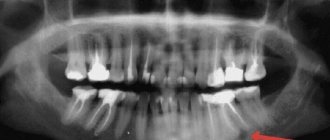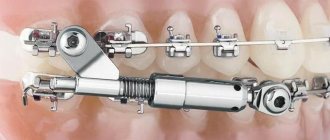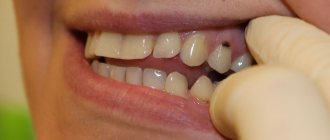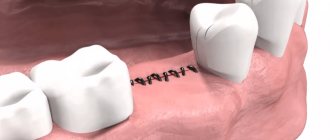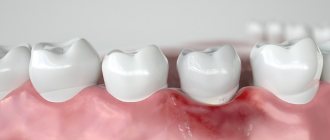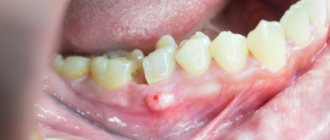Dental implantation is a complex procedure that requires intervention in the soft tissues of the oral cavity. To avoid all sorts of complications, it is very important to follow the dentist’s recommendations. Swelling and redness may be observed for several days after surgery, which is considered normal. If other unpleasant symptoms appear, you should consult a specialist to prevent rejection of the prosthesis and other pathological conditions.
Normal gum condition after implantation
Because the gums are exposed during surgery, your gums may appear inflamed in the first few days after surgery. The patient may experience the following symptoms:
- bleeding;
- pain;
- hematoma.
If symptoms do not subside after a week, you should consult an implantologist.
The implant adaptation period can take from 2 to 6 months, depending on the complexity of the manipulation and the individual characteristics of the body. For example, artificial roots take root faster on the lower jaw than on the upper jaw.
How does healing occur, what consequences of the operation are considered normal?
It is worth mentioning right away that the process of implant integration does not end with the regeneration of soft tissues - osteogenesis must occur, that is, fusion of the bone with the implant. It takes about six months for complete restoration of both bone and soft tissue, starting from the day the pin was installed - even with a step-by-step procedure, this is usually enough. But at the VivaDent clinic, patients are warned that the speed of healing varies from person to person - there are lucky ones who, after three months, do not notice any consequences of the intervention, but there are those patients who really need six months or a little more for full recovery .
In the first hours after surgery, the patient feels numbness - these are residual effects of pain relief. Then a slight pain appears - since the cut tissue cannot help but hurt after the anesthetic wears off, and this is normal. Patients describe the nature of the pain as “pulsating” or “twitching”, and these sensations spread to the jaw area around the socket of the implanted tooth. But you don’t have to endure them at all - the dentist will recommend what painkillers you can use to cope with the pain. As a rule, the pain goes away within four to five days after the intervention.
During the first week, itching in the gums is also possible - and this is considered a normal phenomenon during tissue regeneration.
A month after implantation, the patient stops experiencing any painful or uncomfortable sensations completely - as the surface of the gum and the place where it connects to the abutment heals.
Bleeding from the gums should stop within the first 24 hours (and even then, we are not talking about continuous streams of blood, but drops); then, over the course of several days, the appearance of a small amount of blood or exudate cannot be ruled out.
Also, in the first five days, a slight increase in temperature and the presence of slight swelling of the gums in the area of intervention are considered acceptable. Sometimes the gums of neighboring teeth also swell - this is also normal if it does not last longer than a few days.
If sutures were placed on the gums, the patient should come for examination weekly or more often (as the doctor says), and the sutures will be removed 3-4 weeks after the gums have been sutured.
Possible complications
In most cases, swelling, discomfort, and pain disappear 5-7 days after implantation. If after this time the symptoms do not disappear or increase, you should consult a specialist to rule out the following pathologies:
- hyperplasia. Rapid proliferation of mucous membranes at the implantation site. Elimination will require partial removal of mucous tissue;
- fistulas, purulent foci. A characteristic sign of such consequences may be white dotted plaque on the gums. Inflammation can result from infection during surgery, medical negligence, injury to the nasal sinuses, incorrect choice of implant, poor oral hygiene, and bad habits;
- peri-implantitis. Beginning of prosthesis rejection. Bleeding, severe swelling, redness, pain, and numbness may indicate pathology. In this case, immediate treatment and curettage are required;
- implant rejection. It is rarely recorded in dental practice. Characterized by the mobility of the installed rod. The cause of the violation may be physiological characteristics, doctor errors, chronic diseases in the acute phase, poor hygiene, and bad habits.
To minimize the risk of such conditions, you should follow your doctor's postoperative recommendations.
Dental implantation: healing time, features of care for the operated area.
The operation is not complicated, and the process itself, thanks to high-quality painkillers and modern techniques, is quick and painless. An implant is a titanium rod that is screwed directly into the bone. To do this, soft tissues are dissected, and upon completion of the procedure, to quickly heal them and engraft the artificial root, sutures are placed on the gums. It is during this period, which lasts no more than a couple of weeks, that the patient most acutely feels pain and discomfort. It can take from three to six months for the implant to completely fuse with the bone - everything is individual. It is also important to consider that the rate of tissue regeneration will be different for each person.
Healing after dental implantation depends on the patient’s compliance with all the dentist’s recommendations. To prevent the development of inflammation and complications, it is necessary to carefully monitor the wound. This is due to the fact that the operated area is vulnerable for 2-4 weeks due to bacteria.
In the first two weeks after surgery you must:
- Quit smoking, alcoholic beverages, and solid foods. Eat crushed and semi-liquid food.
- Minimize physical activity.
- Avoid hot, cold foods and drinks,
- Do not chew on the side where the implant is installed.
- Do not touch the operated area with your hands, tongue or various objects.
Oral hygiene should be especially carefully observed, then wound healing will occur quickly and with minimal discomfort. Use a toothbrush to walk around the implanted area; it can be carefully treated with a cotton swab dipped in saline solution. To reduce pain, the doctor may recommend taking painkillers, which are prescribed on an individual basis.
Treatment of postoperative complications
In some cases, after implantation, the patient is prescribed antibiotic treatment, which helps prevent infectious processes. In addition, drugs with an antiseptic wound-healing effect are prescribed:
- chlorhexidine (0.05%). It has a disinfecting effect and is used in the first days after manipulation. The composition should be kept on the side where the implant is installed for several minutes. It is recommended to repeat the procedure 3-4 times a day;
- betadine (10%). Three drops of the composition are diluted with water (100 ml). Rinsing the postoperative area relieves inflammation and heals wounds. The drug provides protection to damaged tissues. Should be used up to 6 times a day;
- dexalgin. Has anti-inflammatory analgesic properties. Relieves pain for 3-6 hours, reduces swelling.
Orthopedic stage of implantation: impact on the gums
- Creating a gum contour
Before prosthetics, a former is installed - this is necessary to form the contour of the gums. Installation takes no more than 20 minutes and looks like this:
- making a small incision;
- unscrewing the plug;
- fixation of the former.
The procedure is performed under local anesthesia. Prosthetics can begin in one to two weeks.
After installing the former, the abutment is fixed to connect the implant and crown.
- Installing a prosthesis over an implant
The main task of prosthetics is to restore the integrity of the dentition. At the same time, it is important not only to preserve the external aesthetics of the prostheses, but also to ensure functionality. This is achieved through the joint efforts of the orthopedist and implantologist.
To make a crown, preliminary impressions are made. Before the final installation, the required number of fittings and corrections are carried out. The duration of the process is 2-4 weeks.
Oral care after implantation
The rehabilitation period takes at least 5 months. At this time, it is important to follow your doctor's recommendations:
- regular scheduled examination;
- using a brush with soft bristles;
- daily hygiene using antiseptics;
- minimizing impacts on the operating area;
- use of an irrigator;
- limiting warming bath procedures;
- adherence to the recommended diet;
- monitoring the condition of the prosthesis;
- to give up smoking.
After dental implant surgery
After installing a dental implant, to ensure the normal course of the healing process, you must follow the dentist’s recommendations. Their implementation will allow the body to ensure that the results of the intervention are recorded and make it easier to bear stress.
Doctors' advice for the first week after the intervention
In the first time after surgery, experts recommend:
- Avoid the possibility of nerve hypothermia when applying a cold compress to the cheek.
- Do not eat before the end of the action of the painkiller, which takes about 2 hours to be completely absorbed.
- Avoid eating spicy, fatty and acidic foods during the first 7 days after the procedure.
- Avoid taking cold and hot food and liquids, giving preference to foods and drinks heated to a warm temperature.
- Ensure that you stay in a position during the day in which your head is located above chest level.
Note! In the first few weeks after implant installation, doctors advise sitting more often, using high pillows for sleeping, and not leaning back while sitting in a chair.
- To avoid impact on the area undergoing surgery, rupture and divergence of sutures, it is recommended to sleep on your side, on the side opposite to the one on which the manipulations were performed.
- Clean hard-to-reach areas of the oral cavity from food debris using dental floss.
- Avoid work associated with moving heavy objects and heavy physical activity, during which pressure is created due to the automatic compression of teeth, which can negatively affect the process of implant healing.
In addition to the recommendations listed, safe and rapid healing can be ensured by the use of painkillers (Ketonal, Nise), Curasept disinfectant rinse, and topical wound healing ointment Solcoseryl.
Recommendations from dentists for the second and subsequent weeks after the procedure
Despite the fact that with normal care, after the first 7 days after surgery, partial healing of the affected structures and bone tissue around the implanted element is observed, dentists recommend that patients follow the instructions. After the first week, if healing is successful, based on the results of a routine examination, the dentist may allow the sutures to be removed; in more severe cases, it will take about 3 weeks for them to be removed. Recommendations from specialists at this stage of restoring the integrity of dentition elements may include advice regarding:
- The need to ensure proper oral care, avoiding the use of products with a powdery consistency when brushing your teeth.
Important! Qualified dentists recommend refraining from brushing your teeth with toothpaste; they recommend giving preference to a gel, which will ensure the safety of the gums while completely eliminating pathogenic microflora.
- Quitting smoking, since nicotine entering the body leads to the destruction of bone structures, weakening of the gums, which provokes the development of inflammatory processes and necessitates the need for additional therapy.
- The need to avoid touching the area where the implant is located using the tongue, fingers or mechanical devices.
Note! To speed up the process of tissue regeneration in the damaged area of the oral cavity, it is recommended to rinse with a saline solution diluted in the proportion of 1 teaspoon of salt per 200 ml of warm water.
- When choosing the right toothbrush, it is recommended to choose one with soft bristles or purchase a children's brush.
- Adjusting the diet to increase the amount of foods high in calcium (dairy products, white cabbage).
- The need to avoid air travel, climbing to heights, and visiting saunas and steam baths.
- Avoiding alcohol (for at least 1 month), the use of which dulls the sense of pain and reflexes. As a result, if the area where the intervention is located is damaged, the patient will feel pain after a certain period of time, which increases the risk of complications due to delayed medical care.
- The need to avoid eating sticky and hard foods, such as nuts, carrots, crackers, seeds and stretchy sweets until bone and soft tissues have completely healed.
Important! In most clinical cases, pain symptoms disappear after 7 days, but if you experience discomfort after the specified time period, you should consult your dentist. Most likely, he recommends taking Ibuprofen over the next few weeks, emphasizing the need to respect the timing and dosage of taking this potent drug.
The frequency of visits to a specialist decreases as rehabilitation progresses from once every 1.5 weeks during the first 2 months after the procedure to one visit every 6 months after complete restoration of the damaged structures with an implanted element.
What is implant failure?
Dental implantation is a traumatic and complex procedure that requires a long rehabilitation period (from 3 to 6 months). This period does not always proceed smoothly; soft tissue swelling, pain, bleeding and other unpleasant symptoms may occur. If the listed symptoms do not stop, this may be a sign of implant rejection. Failure to engraft artificial teeth implanted into bone tissue can occur at different stages of implantation:
- from its beginning to the moment of prosthetics, when the operation is performed incorrectly;
- during the first two years after installation, which is often caused by a high load on the implant or non-compliance with the rules of oral hygiene;
- after two years of using a denture, when the patient does not take good care of the oral cavity.
The percentage of probability of implantation of artificial teeth largely depends on the quality of the chosen prosthesis, the individual characteristics of the patient, and the experience and professionalism of the doctor. Rejection is accompanied by severe unpleasant symptoms.
How to care for implants and your mouth after installation
After implantation, you need to follow a number of rules that will speed up the engraftment of the artificial root. The implantation site should be subject to as little trauma as possible. To do this you need to adhere to the following rules:
- Brush your teeth regularly with a soft toothbrush;
- Intensive mouth rinsing is prohibited before removing sutures;
- oral baths with antiseptic solutions or herbal decoctions are allowed;
- you can use dental floss;
- You should visit the doctor at least 2 times a week before the stitches are removed.
Reasons for rejection
The question of why the installed implant did not take root cannot be answered unambiguously, since there are a number of factors that can interfere with this process. These include:
- low quality of the implant (in order for artificial teeth to take root with a higher probability, you need to choose products from trusted brands);
- non-compliance with doctor's recommendations and oral hygiene;
- poor quality work performed by the dentist;
- high load on the artificial tooth;
- allergic reaction to materials included in the implant.
Also, the implant may not take root in case of immune diseases, when it is impossible to predict the result of implantation.
How does healing proceed after dental implantation and in what time frame?
Healing period after implant installation
Recommendations after implantation: what is possible, what is not
Dental implantation is a complex and responsible procedure, the result of which depends not only on the professionalism of the doctor, but also on whether you follow the recommendations in the postoperative period. The implant must take root properly in order to subsequently take on the load of the natural tooth, and this is a slow process. Failure to comply with medical instructions can negatively affect the outcome of the operation and lead to complications, including rejection of the artificial root.
What it is?
The gum former is a miniature titanium cylinder with a screw stem, identical in size to the future abutment. Thanks to the fine threads, the superstructure is securely attached to the implant. After installing the gum former, soft tissue begins to grow around it, forming an even, beautiful contour.
The former is often confused with the abutment. In fact, the functions of these elements are different:
- An abutment
is an adapter between the root part of the implant and the prosthesis. It is needed for reliable fastening of the orthopedic structure to the titanium root; it is installed after the formative superstructure has completed its task of restoring the anatomical shape of the gums. - A former
is a temporary structure that is used to create a regular, even gingival contour around the implant.
The element can be installed immediately
after implantation of the implant into the jawbone, or
3-6 months
after surgery (when the artificial root fuses with the bone tissue).
Lifestyle recommendations immediately after implantation
Let's look at the current list of to-dos and rules of behavior that can and should be followed immediately after implantation:
- Immediately after implantation, you need to rest in a calm environment: it is better to get home by taxi or with one of your relatives - because The anesthesia has not yet worn off and there may be some confusion. At work, you can take 3-5 days off or leave, so that all the body’s forces are directed only to recovery,
- At home, it is recommended to make cold compresses to reduce and relieve swelling: to do this, wrap an ice pack in a towel and apply it to the cheek for 7-10 minutes, repeat the procedure after 3-5 minutes. This can be done for 1.5-2 hours. It is recommended to make 2-3 hikes per day,
- You can drink 3 hours after implantation: it can be pure water without gas or a weak herbal decoction, unsweetened fruit drink/compote. The optimal liquid temperature is about 36 degrees,
- You can eat food 4-5 hours after the operation (we’ll tell you more below),
- do not forget to take medications prescribed by the implantologist.
Read on the topic: how to relieve swelling after dental implantation - the best methods and medications.
What should you not do after installing implants? There are certain restrictions in everyday life (which last on average 14-30 days) - these are visiting the pool, hot baths, air travel, playing sports, overexertion, lifting weights. It is also strictly forbidden to heat the sore spot on the cheek, because this increases swelling and provokes inflammation. And it is extremely important to quit smoking for at least 3-5 days, because... tobacco smoke contains a whole “bouquet” of harmful substances that slow down regeneration[1], and hot air dries out the oral mucosa.
“After dental implantation, and they put 6 pieces on my jaw at once, the doctor told me not to leave the city for a week while the rehabilitation was underway. So that if something happens, you can immediately come to him for an appointment. To be honest, the plan was to come to the clinic almost every two days. Although I would have come on the third day without any reminders, because my cheeks were swollen and I was scared. It’s better to come on time and be cured right away (if anything) than to develop complications later.”
Larisa Mikhailovna, review from the woman.ru forum

